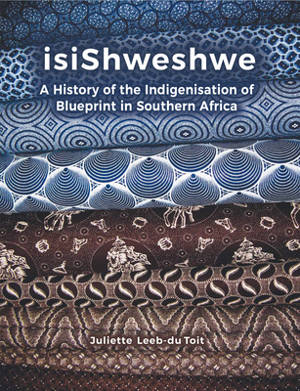
- Afhalen na 1 uur in een winkel met voorraad
- Gratis thuislevering in België vanaf € 30
- Ruim aanbod met 7 miljoen producten
- Afhalen na 1 uur in een winkel met voorraad
- Gratis thuislevering in België vanaf € 30
- Ruim aanbod met 7 miljoen producten
Zoeken
Isishweshwe
A History of the Indigenisation of Blueprint in South Africa
Juliette Leeb-Du Toit
Paperback | Engels
€ 99,45
+ 198 punten
Omschrijving
The cross-cultural usage of a particular cloth type called 'blueprint' is central to South African cultural history. Known locally as seshoeshoe or isishweshwe, among many other localized names, South African blueprint originated in the Far East and East Asia. Adapted and absorbed by the West, blueprint in Africa was originally associated with trade, coercion, colonisation, Westernisation, religious conversion, and even slavery, but residing within its hues and patterns was a resonance that endured. The cloth came to reflect histories of hardship, courage, and survival, but it also conveyed the taste and aesthetic predilections of its users, preferences often shared across racial and cultural divides. In its indigenisation, isishweshwe has subverted its former history and alien origins to come to reflect the authority of its users and their culture, conveying resilience, innovation, adaptation, and above all a distinctive South Africanness. In this beautifully illustrated book, Juliette Leeb-du Toit traces the origins of the cloth, its early usage and cultural adaptations, and its emerging regional, cultural, and aesthetic significance. In examining its usage and current national significance, she highlights some of the salient features associated with histories of indigenisation. An art historian who has a particular interest in African and South African art, Juliette Leeb-du Toit has also had a lifelong interest in design and textiles. She is currently engaged in the recovery of modernisms in design history, the impact of German modernism in South Africa, and the impact of China on the arts in South Africa. [Subject: History, African Studies, Art History, Textile Design]
Specificaties
Betrokkenen
- Auteur(s):
- Uitgeverij:
Inhoud
- Aantal bladzijden:
- 312
- Taal:
- Engels
Eigenschappen
- Productcode (EAN):
- 9781869143145
- Verschijningsdatum:
- 1/11/2017
- Uitvoering:
- Paperback
- Formaat:
- Trade paperback (VS)
- Afmetingen:
- 190 mm x 234 mm
- Gewicht:
- 952 g

Alleen bij Standaard Boekhandel
+ 198 punten op je klantenkaart van Standaard Boekhandel
Beoordelingen
We publiceren alleen reviews die voldoen aan de voorwaarden voor reviews. Bekijk onze voorwaarden voor reviews.











